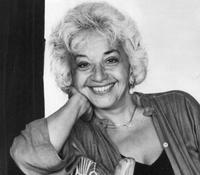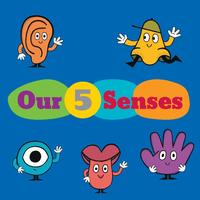In preparation for the opening of Our Five Senses, a new exhibition running now through November 2 in Parkway Central Library's Dietrich Gallery, we've had the honor of sitting down with some of the authors and illustrators who appear in the show. It seems fitting to start the converstaion with Aliki Brandenberg, the inspiration for the exhibit. In 1979, Aliki donated many of her works to the Free Library's Children's Literature Research Collection, one of the largest repositories for Children's Literature in the country.
This is truly an honor, Aliki, as your works have taught and inspired young children for generations. Librarians may assoicate you with Europe because of your time in Switzerland, Greece, and the UK, but you have a strong Philadelphia connection, having attended the Philadelphia Museum School of Art (now the University of the Arts). Why did you choose to go into the arts, specifically children's books?
It always takes a complicated paragraph to explain that I lived in Philadelphia but I was born on Labor Day in Wildwood Crest, New Jersey–on my family's vacation, a first generation Greek American.
I was always drawing.
My kindergarten teacher made my parents aware when I drew two families, both with three girls and a boy named Peter. One was Peter Rabbit. Ours was my brother, Peter Liacouras.
We lived in Philadelphia until we moved to Yeadon, PA when I was in third grade, and I owe a great debt to our incredible local elementary and high school where music and art flourished. (Bell Avenue Elementary and Yeadon High School)
I started Saturday art classes at Philadelphia Montgomery Christian Academy when I was 11, and there was no doubt I would follow after high school, studying illustration.
After graduation, I got my first and only job at JCPenney Company in New York designing displays for the country, and loved it. But after a year I returned home and began freelancing in commercial art, greeting cards, and advertising in Philadelphia, then New York, and later Switzerland, where I was given a book to illustrate. Since I was living in William Tell country with my new husband, I wrote my first book, The Story of William Tell, but I still continued in my advertising career. It was not until we moved back to New York in 1960 that the book in my portfolio brought me another book to illustrate, The Listening Walk by Paul Showers, published by Thomas Y Crowell. I loved the freedom of illustrating as I wished, without an art director peering over my shoulder.
Before I finished, I wrote My Five Senses and chose a career of creating books instead of ads for terrazzo floors and cat food.
When you phrase it like that, I don't know who would choose floors and cat food. Let's talk a little more about My Five Senses, as it inspired our exhibiton. What was the inspiration for the book?
The idea must have been in my DNA. One Friday night I lay on the couch and began to write. My Five Senses came out verbatim, like a baby born in half an hour. I made the dummy over the weekend and took it quaking to Elizabeth Riley, my formidable editor. [Note: A "dummy" or "dummy book" is a mock-up created by authors and illustrators to see where text placement will go and how it will interact with the artwork.] She accepted it without changing one word for their new Let's Read and Find Out series. I thought, This is easy, I'll write more books. Little did I know...
We think a lot of authors and illustrators think that at first. Thank you for mentioning your dummy, it is one of the items on display in the exhibiton, so visitors will have the opporunity to view it. The text of My Five Senses is sublime. You haven’t wasted a word throughout the book and you are a master of explaining these complex senses to young children. Can you tell us a little about your writing process and how you craft the text of your books?
Thank you for your touching compliments. I didn’t know what I was doing. That's the way it came out. I didn’t know yet that choosing words carefully, editing, deleting, discarding, revising, were all prerequisites to writing children's books. That less is more. That every word counts, and must mean something.
I love words. I have written all my life: letters, feelings, diaries. I had read and collected children's books—not with thoughts of writing them. I never thought to be a writer, but I needed words to illustrate. I seemed to know what to leave out and get to the point. I have no idea why my book has lived so long, but I feel grateful and very lucky.
"Crafting Text" changes with the book. I write fiction, "feelings" books that come from within, and nonfiction, that come from wonder and research. With fiction, my own words matter, they are mine to describe the emotion of missing a best friend, a grandfather's death, or an immigrant’s pain.
Nonfiction means specific wording for facts and research, more than ever demands truth, clarity, choice, paring away redundant words or repetition, finding the most descriptive word to explain why or how Egyptian mummies were wrapped and buried, or what our senses mean to us.
I, especially, tighten my scripts because as an illustrator, I want the drawing to enhance what the words don't. That's also why I use captions and speech bubbles—my need to add more information without burdening the text.
When I was asked to write a book about dinosaurs, I knew they were big and dead, but I didn’t know one can't exaggerate science, as I did. The tails, the bodies, the necks, all have to be accurate. There is always someone who knows more than you. That lesson served the rest of my life. Digging into anything fascinating brings surprises. I grew to love dinosaurs.
That is a fantastic description for both fiction and nonfiction. We now want to reread your books and see how the fictional titles differ from the nonfiction. Talk to us a little about the artwork from My Five Senses. Visitors will see a lot of your final artwork, the color separations that created the book. We love it because of its striking color palette: lime, turquoise, white, and black. Why did you use these colors?
I'm so glad you like it. In the '60s and before, full (4) color printing was very expensive. Most books—including the Let's Read and Find Out series—were printed in three colors on one side of the sheet, and one color (black) on the back. The artist had to tediously hand-separate each color on acetate overlays. One color over another produced an extra color. I guess coming from my design background, I chose to stress the important subjects and actions in black, and use the limited color as design. Besides, I was learning.
In the 1980s, you updated the artwork for My Five Senses. The artwork is totally different and the child protagonist has gone from a male character to what appears to be a gender neutral character. What brought about this change? Looking back, which artwork do you prefer?
Well, we do change with the times and books are a reflection. That's history.
New four-color presses made printing full color books more accessible [Editor's Note: See How A Book Is Made by Aliki :) and publishers were excited, but not everyone liked the choice. For example, I chose not to redo Corn is Maize. I didn't think anything would be gained by full color, and many agreed.
But I was happy with the chance to redo My Five Senses. It was time for a new character. An ethnic child (I love that little boy). But you’re right, and very observant—I did try to make him either/or, so a boy or a girl could see him, or herself in the child, or not think about it.
Hmmm, which do I like better? Well, I couldn’t do the original again if I tried, nor do I want to denounce it. It is what it is: of the time, place, experience... though I grew in between. And the same could be said for the second edition.
We keep growing and changing, always with the potential of doing better.
That line is the perfect ending. Thank you Aliki for your time and your inspiring work!
Our Five Senses will be open from May 13 - November 2, Monday-Saturday 9:00 a.m. - 5:00 p.m. For more information, please visit www.freelibrary.org/fivesenses
Support for this exhibition has been generously provided by Independence Foundation and PNC. The Free Library of Philadelphia gratefully acknowledges additional contributions from individuals.
Have a question for Free Library staff? Please submit it to our Ask a Librarian page and receive a response within two business days.



